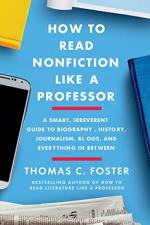
|
| Name: _________________________ | Period: ___________________ |
This quiz consists of 5 multiple choice and 5 short answer questions through Section 5: Chapter 16, "Social (Media) Disease" through "Conclusion".
Multiple Choice Questions
1. In Chapter 5, "It May Just Be Me, But..." what does Foster say about offering a source the chance to correct themselves if they claim that they misspoke?
(a) This in unethical.
(b) This creates inaccuracies.
(c) This is part of the fair treatment of sources.
(d) This can make a story stronger.
2. In Chapter 11, "Life from the Inside," what does Foster call works that people write about their own experiences with illness and dying?
(a) Survival autobiography.
(b) Misadventure memoir.
(c) Death memoir.
(d) Funeral autobiography.
3. In Chapter 10, "From the Inside Out," what type of nonfiction writing does Foster refer to as "soggy" (141), and "soul-deadening" (142)?
(a) The philosophical essay.
(b) The five-paragraph academic essay.
(c) The essays of the Enlightenment.
(d) The political essay.
4. In Chapter 10, "From the Inside Out," says that political cartoons and punditry are examples of what type of nonfiction?
(a) Op-ed.
(b) Opinion.
(c) Immersive journalism.
(d) News features.
5. In Chapter 16, "Social (Media) Disease," Foster uses the expression "a funny thing happened on the way to the forum" (267-268). What device is he employing, here?
(a) Symbolism.
(b) Sarcasm.
(c) Parallelism.
(d) Allusion.
Short Answer Questions
1. In Chapter 14, "The Universe of Ideas/Ideas of the Universe," what criticism does Foster level against Malcolm Gladwell?
2. Based on Chapter 14, "The Universe of Ideas/Ideas of the Universe," what would Foster call a journalist writing a general survey of the field of string theory?
3. In Chapter 15, "Reading Internet Sources," what does Foster call the "fatal flaw" of the internet?
4. In Chapter 2, "The Ecology of the Nonfiction Biosphere," Foster notes that the expectation for a writer to be engaging does not apply to which types of writing?
5. In Chapter 14, "The Universe of Ideas/Ideas of the Universe," what does Foster seem to admire most about Neil deGrasse Tyson's writing?
|
This section contains 393 words (approx. 2 pages at 300 words per page) |

|




